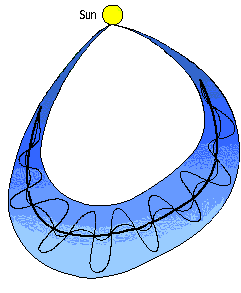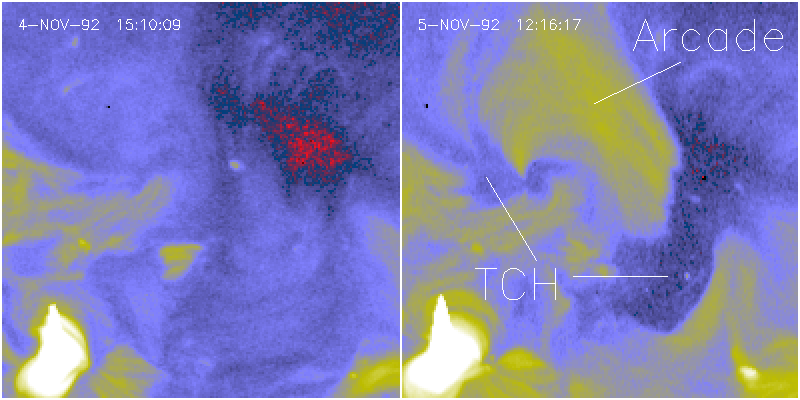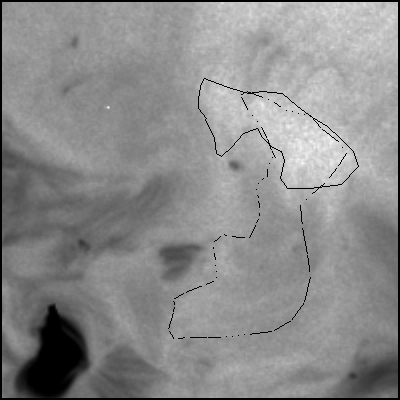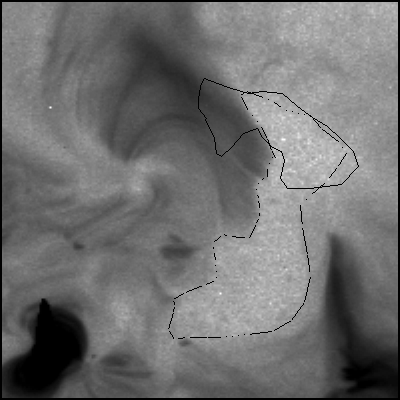
The solar activity level has been at its highest pitch of the present maximum, with nine X-class flares within the past month, from three independent active regions. Accordingly our science nuggets have emphasized these great observations. However - let's take a break and pick up a little-discussed subject, but an important one: the nature of "transient coronal holes."
The background of this subject appears in an important but somewhat obscure paper by D. Rust, based upon Skylab data. This paper noted the recently-found association of high-speed streams in the solar wind and coronal holes. We define coronal holes below, and mention here that Waldmeier had introduced this term (but in German) long before Skylab or Yohkoh. Rust also knew about CMEs, which appear to open up coronal magnetic field lines, thereby providing the entry of excess flows in the solar wind. Putting two and two together, he searched for and found "transient coronal holes" opened by LDE flares, which have strong CME associations.
This definition is taken from Karen Harvey's work. A coronal hole is a region that is brighter than the average quiet Sun as seen in the helium line at 10,830 Angstroms; the internal network structures must have low contrast; the region should be predominantly unipolar; the area should be larger than about two supergranules in size; and the boundaries of the region should separate higher and lower contrast areas for the network. All of this is pretty technical, but basically there's a nearly one-to-one mapping between these criteria and X-ray coronal regions that are very dark.
Since Rust's paper, and making use of Yohoh and SOHO data, we've been routinely observing "double dimmings" that match his pattern. There are several science nuggets on events of this type, including a recent nice one as well as the original Yohkoh science nugget. The basic idea of these early descriptions is that a flux rope flies away from the Sun, either created on the spot by magnetic reconnection in the "tether cutting" scenario, or otherwise, The dimming regions would be the photospheric footprints of an interplanetary flux rope or magnetic cloud:

In essence this follows Rust's ideas. The picture should be self-explanatory - a twisted magnetic volume escapes from the Sun, leaving its footpoints behind as a double dimming.
But certainly the picture is not that simple. This nugget points out some of the complications, in the context of a transient coronal hole observed by Yohkoh in the distant past - 1992..
Here's a view of a quiet coronal region, Nov. 5, 1992, which developed an arcade and a pair of transient coronal holes (click to enlarge; don't be put off by the rococo color table - for coronal-hole definition, red is equal to dark blue):

It is striking to note that one of the holes is much larger than the other. A study under way now by S. Kahler finds that in fact this is common, and it often happens that only a single coronal hole may develop. Interestingly different from the standard double dimming version we would like to associate with the ejection of a flux rope, as described above. In this case the event occurs near disk center, so there is little likelihood of confusion via obscuration by foreground material - we always have to bear in mind the 3-dimensionality of the solar corona.
Another striking new finding is the pattern of growth and decay. We illustrate this with contour overlays from before and after (reversed colors, much clearer; click to enlarge either "before" or "after"):

|

|
We find that the larger of the transient coronal holes greatly expanded a previously existing "permanent" hole. Then it contracted slowly, taking more than two days to disappear. We note the following:
These characteristics are typical, and neither these properties nor the idea that a single transient coronal hole (or none whatsoever) seems very consistent with the flux-rope picture depicted above, nor with many a cartoon model of flare or CME development.
The opening of a new coronal-hole region requires a balance of positive and negative flux. When we only see one of these polarities, the other must be hidden in some other feature - a remote coronal hole, dispersed small open regions in the quiet corona, or possibly even sunspot umbrae. It will be exciting and perhaps important to find this missing flux.
The opening and closing of coronal magnetic field lines often is explained by local physics such as magnetic reconnection localized by some magical process. This invariably, according to the cartoons, releases energy and causes heating. At the outer boundary of a hole such as this we see no evidence for excess brightening during the closing-down. The logical inference is that magnetic reconnection may not be such an energetic process, and may be dictated more by global coronal conditions than by local physics. Again, it will be exciting and perhaps important to learn how the Sun does this.
April 27, 2001